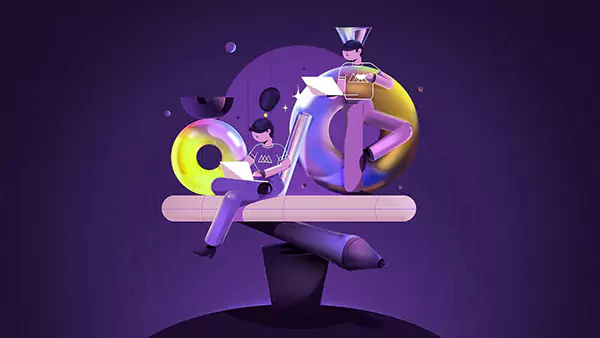Visual media has become an integral part of modern advertising and storytelling, enabling businesses to captivate their audience in unique and imaginative ways. In recent years, the use of visual media without real actors has gained significant traction as a powerful medium for brand campaigns. Two popular techniques in this realm are motion graphics and animation. Although often used interchangeably, motion graphics and animation are distinct disciplines with their characteristics.
One of the primary reasons Expert Motion Graphic Designers rely on this form of art is because of its ability to create captivating and immersive narratives that transcend the limitations of reality. In animation and motion graphics, the possibilities are limitless. Brands can transport their audience to fantastical worlds, bring inanimate objects to life, or showcase complex processes in a visually engaging manner. This flexibility allows businesses to tell their stories in unique and memorable ways, captivating the attention of their target audience.
In the realm of animation, we have witnessed the rise of animated characters that have become synonymous with their respective brands. These characters have successfully established themselves as brand icons, recognized worldwide. Consider the charming red-haired mermaid, Ariel, from Disney’s “The Little Mermaid,” or the mischievous and evergreen Bugs Bunny from Warner Bros. These characters have become powerful brand assets, resonating with audiences across generations and helping to build lasting brand recognition.

Motions Graphics Vs Animation
Now, let’s delve into the specific definitions and characteristics of motion graphics and animation:
Motion Graphics
Motion graphics refer to the art of bringing graphic elements to life through movement. It involves manipulating text, shapes, illustrations, and other visual components to create visually dynamic and engaging content. Motion graphics are commonly used to enhance videos, presentations, user interfaces, and digital advertising. The primary goal of motion graphics is to convey information effectively and add visual interest to various media formats.
Animation
Animation, on the other hand, involves creating the illusion of movement through a sequence of images. It brings characters, objects, and environments to life by carefully animating their movements. Animation is frequently used in films, television shows, advertisements, and video games. It focuses on storytelling and character development, allowing for rich narratives and emotional connections with the audience.
Differences between Motion Graphics and Animation
Focus
Motion graphics primarily focus on visualizing information and enhancing the presentation of content. Animation, on the other hand, centers around characters, and narratives, and creates engaging stories.
Design Elements
Motion graphics predominantly use graphic elements such as typography, icons, and illustrations to convey messages. Animation, on the other hand, involves creating lifelike movements and interactions for characters, objects, and environments.
Scope of Application
Motion graphics are widely used in videos, presentations, user interfaces, and digital advertising to enhance visual appeal and communicate information effectively. Animation finds its applications in films, television shows, advertisements, and video games to tell stories and create immersive experiences.
Commonalities between Motion Graphics and Animation
Visual Communication
Both motion graphics and animation rely on visual elements to communicate messages and engage audiences effectively. They leverage the power of visuals to capture attention, evoke emotions, and convey complex ideas.
Storytelling
While the focus of storytelling may differ, both motion graphics and animation excel in conveying narratives. Motion graphics employ graphical elements to present information compellingly, while animation develops characters and narratives to engage the audience on an emotional level.
Motion Graphics Use Cases
Suppose a brand wants to create an advertisement for a new smartphone. They could utilize motion graphics to showcase the device’s key features and illustrate how it enhances the user experience. Through animated graphics, they can highlight the phone’s sleek design, advanced camera capabilities, and intuitive user interface, creating a visually captivating advertisement.
TV Opening Credits
Motion graphics have been a staple in the opening credits of TV miniseries for quite some time. The latest Netflix box sets often showcase captivating motion graphics that set the tone and atmosphere of the show while capturing the attention of viewers from the start.
Advertising Creative
Motion graphics have revolutionized advertising creativity by enabling advertisers to create bold and interactive visuals for their clients. Advertisements now feature engaging animations, dynamic typography, and visually striking effects that captivate audiences and leave a lasting impression.
News Broadcasting
Motion graphics play a crucial role in news broadcasting, allowing broadcasters and journalists to effectively convey information and tell stories. Particularly during news events such as elections, motion graphics help present data, statistics, and key information in a visually compelling and easily digestible manner.
Animation Use cases
Imagine a brand that wants to promote a new line of children’s toys. They can develop animated characters that embody the spirit and personality of each toy. Through an animated story, they can showcase the adventures and imaginative play that children can experience with these toys. By building an emotional connection with the audience, the brand can establish a long-lasting impression and generate interest in its products.
Animation provides storytellers with a remarkable opportunity to narrate tales in distinctive and captivating ways. The immersive and imaginative realms found in animated films can reignite inspiration and evoke the magic of storytelling, transcending age barriers. Whether you are already a storyteller or aspire to become one, animation serves as an ideal starting point to unleash your creativity and bring your narratives to life.
Conclusion:
The current generation has known the art of animation as a modern-age tool that resorts to characters and storyboards. Motion graphics also emerged in the early 20th century, making most of us feel that all that graphics is animation. Whatever the reason, as long as use cases are understood, you can choose the right medium that will help with your next project. In case you have to play with words and text, using motion graphics will serve the purpose. In all probability, one can use motion graphics and animation in the same project if it is serving an individual purpose without distorting the context. Overall, both mediums are a great way to proceed to gain good content mileage.